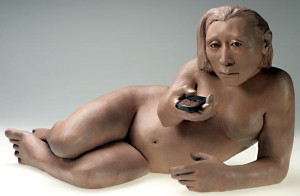BREAKING THE SURFACE
Roxanne Swentzell was born in 1962, the daughter of Rina Swentzell, a potter, writer and scholar from Santa Clara Pueblo, and Ralph Swentzell, a New Jersey-born teacher at St. John’s college in Santa Fe. From her father’s side she was exposed to Gregorian chants on the stereo, painting by Rubens and sculpture by Michelangelo. On the Pueblo side there were dances and feast days, drumming and singing, pottery making and a Tewa name: Ojegepovi, which means “frost flower,” or “snowflakes,” in recognition of the season in which Roxanne was born.
For her last two years of high school, Roxanne attended the Institute of American Indian Arts in Santa Fe, where she was given the first exhibition of her clay figures. Later she studied at the Portland Museum Art School in Oregon.
Today Roxanne’s work, much of which is also produced in bronze limited editions, is collected internationally. It is in the permanent collections of the Heard Museum in Phoenix, the Denver Art Museum and the Museum of Wellington, New Zealand, among others. Her art has earned numerous honors, including many first-place and best-of-class awards at Santa Fe Indian Market and the Heard Museum Guild Indian Fair and Market. Her work is extensively exhibited in museums and galleries, and in 1997 “Emergence of the Clowns” was part of “20th Century American Sculpture at the White House: Honoring Native America.” She currently is represented by Hahn Ross Gallery in Santa Fe, NM (for bronzes), Blue Rain Gallery in Taos, NM, Four Winds Gallery in Pittsburgh, PA, and Faust Gallery, Scottsdale, AZ.
Taken from: Gussie Fauntleroy’s Extraordinary People, New Mexico Magazine Artist Series, Ethel Hess, 2000.
The exhibition was on display September 4, 2004 – October 24, 2004.
BOOKS AT PROVISIONS
Roxanne Swentzell: Extraordinary People
Gussie Fauntleroy, New Mexico Magazine Artist Series
The fourth title in New Mexico Magazine’s Artist Series showcases the work of Roxanne Swentzell, one of the most intriguing and acclaimed contemporary sculptors in the Southwest.
Pueblo Artists: Portraits
Toba Pato Tucker, et al.
Toba Pato Tucker spent two and a half years creating portraits of Pueblo artists and art-making families that reveal the generational links among potters, silversmiths, drum makers, weavers, and painters. Tucker has produced a masterful and honest collection of portraits that document and explore the nature of traditional Pueblo life and its intersection with the non-pueblo modern world. Alfred L. Bush, curator of the Princeton Collections of Western Americana, traces the long history of portrait-making among the Pueblos. Architectural historical Rina Swentzell, herself from Santa Clara Pueblo, explores the rift between traditional values of the community and the status of the individual artist. Nambe Pueblo artist Lonnie Vigil acknowledges that for Pueblo artists art cannot be separated from family and community life.
Fourteen Families in Pueblo Pottery
Rick Dillingham
In 1974 Seven Families in Pueblo Pottery was published to accompany an exhibit at the Maxwell Museum of Anthropology; twenty years later there are some 80,000 copies in print. Like Seven Families, this updated and greatly enlarged version by Rick Dillingham, who curated the original exhibition, includes portraits of the potters, color photographs of their work, and a statement by each potter about the work of his or her family.
Clay People
Wheelwright Museum of the American Indian
Case Trading Post
This catalog illuminates the historic figurative tradition, especially of Cochiti and Tesuque pueblos, as well as the work of three innovative contemporary ceramists who are inspired by the human form–Nora Naranjo-Morse and Roxanne Swentzell of Santa Clara Pueblo, and Virgil Ortiz of Cochiti Pueblo. 11 x 8 1/2″; 96 pages, 12 color and 50 duotone illustrations including more than 75 figurative ceramics.
Talking With the Clay: The Art of Pueblo Pottery
Stephen Trimble
Galleries and shops across the United States are filled with American Indian art. Especially popular is the striking pottery handmade by the Pueblo Indians of the Southwest. Talking with the Clay tells the story of this pottery from the uniquely personal view of the potters themselves. Stephen Trimble interviewed sixty artisans in the pottery-making Pueblo villages, from Taos, New Mexico, to the Hopi reservation in Arizona. Their eloquence fills this book.
BOOKS
Permaculture: A Designer’s Manual
Bill Mollison
The must-have text book for anyone interested or practicing permaculture.
Agropolis: The Social, Political and Environmental Dimensions of Urban Agriculture
Luc J. A. Mougeot, ed.
Surviving in Two Worlds: Contemporary Native American Voices
Lois Crozier-Hogle and Darryl Babe Wilson, eds.
Includes a chapter by Roxanne Swentzell that reflects on permaculture.
EDUCATION
Global Environmental Management Permaculture Design Certificate Course
At the University of Wisconsin – Milwaukee’s Field Station, June 5-12, 2011
FILMS
Conversations with Roxanne Swentzell
A short film by Pat Ferrero
Edible Landscapes
Purchase this video in which Joel Glanzberg and Roxanne Swentzell show how to transform a barren landscape into a nurturing edible landscape through permaculture methods. Code # 511
ORGANIZATIONS
Central Rocky Mountain Permaculture Institute
Permaculture training, counseling, research and development center. The Institute is part of an alliance of Permaculture activists on the cutting edge of agroforestry and other newly discovered methods of organic farming.
Flowering Tree Permaculture Institute
Founded by Roxanne Swentzell
PO Box 4154
Fairview, NM 87533


